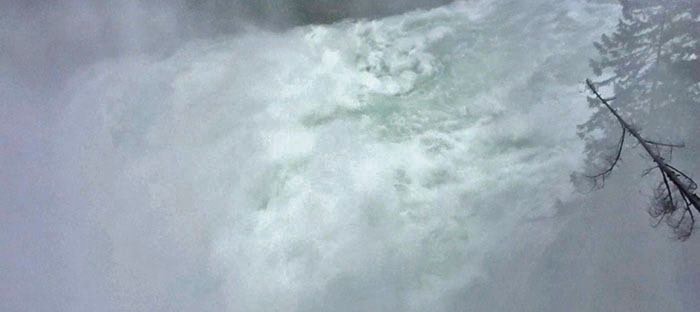The series of storms over the past week have set a record for total water inflow volume into the Campbell River system, BC Hydro says.
“The rain keeps coming and the upper Campbell River watershed has received 100 to 150 mm since the current storm began Sunday night,” BC Hydro spokesperson Stephen Watson said.
And a midweek reprieve will be swept aside by moderate to heavy rainfall events predicted for Thursday to Friday and then again Sunday to Monday.
Meanwhile, this period of storms set a new record for inflow volume into the Campbell River system.
“Our records go back to 1963, or 53 years,” Watson said.
Meanwhile, this morning , the hourly inflow rate was around 1,300 cubic metres per second.
“This is the highest water inflow rates observed so far during this storm,” Watson said. “That’s the equivalent of an Olympic sized swimming pool (2,500 cubic metres per second) entering the reservoir every two seconds. BC Hydro increased the flood risk management spill through the system, out of the John Hart project, on Monday to 500 m3/s (cubic metres per second), with 380 m3/s going over Elk Falls.”
With more water coming into the reservoir than discharges downstream, the Upper Campbell Reservoir/Buttle Lake has risen about 0.6 metres since 2 p.m. Monrday and is now at 220.7 metres.
“BC Hydro is trying to keep the reservoir level from the 222 metre level as this is where we begin to pass inflows into the reservoir downstream,” Watson said.
This afternoon, BC Hydro intends to increase the spill through the system by an additional 60 cubic metres per second to 560 m3/s.
“This is the same flow level that was reached in 1995 and one of the highest downstream flow rates in our records,” Watson said.
Four hundred and forty cubic metres per second will be going over Elk Falls. Watson said it is important for the community to know that BC Hydro’s dams are operating as intended and are designed to safely manage reservoir levels and pass inflows at these elevated levels.
The challenging situation is in the downstream river area where we are seeing more natural river flows which doesn’t benefit from upstream attenuation and dam regulation, Watson said.
Consequently, the likelihood for increasing downstream flooding in the Campbellton area of Campbell River has now increased. With the planned discharge rate 560 cubic metres per second from BC Hydro facilities, the unregulated Quinsam River and ocean tides may combine to cause isolated flooding along the river down to the estuary. Flows greater than this are also possible, though currently not forecasted, Watson said. The flood risk will likely exist through this week.
Today, the City of Campbell River issued another advisory to the public about the risk of flooding.
“Again, the city is reminding residents in this area that they should be prepared for water levels to potentially overtop the river bank in the coming days – and that this could cause localized flooding on properties along the river and in nearby low-lying areas through the coming week,” the city’s advisory says.
Homeowners are advised to take precautionary measures to shore up their property and can get supplies for sandbags at the City’s Dogwood Operations Centre (385 S. Dogwood – enter from driveway on Merecroft to access sand and bags).
The city notified property owners along the river over the weekend and will continue to monitor the weather and river levels, and crews are on call to assist as necessary. Call 250-287-7444 for after-hours emergency assistance.
Supplies are also available at the Emcon yard at 7025 Gold River Hwy (intersection of highway and Argonaut Rd).
Also, residents are advised to keep a safe distance from the river because of wet, slippery conditions and fast-flowing water. It is most dangerous above Elks Falls, where safety signs are posted.
Watson said BC Hydro remains closely engaged with the City of Campbell River, Strathcona Regional District and Emergency Management BC.
“Please stay away from the Campbell River with these very high and dangerous flow rates,” he said.
